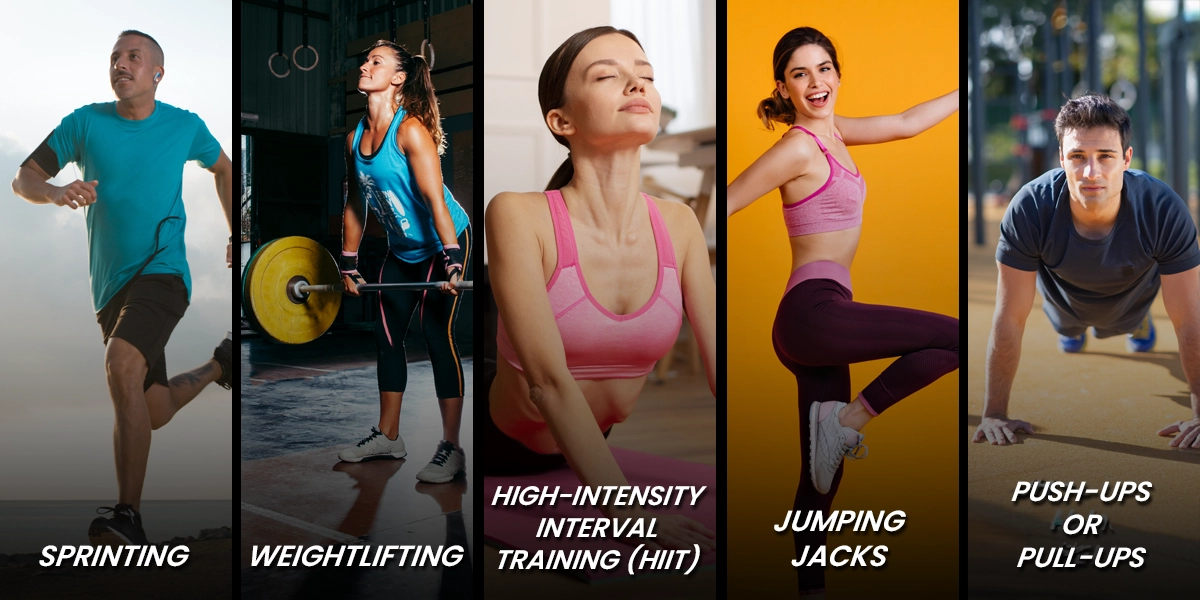
A 40-year-old fitness enthusiast, Ramesh enjoys staying active and trying different workouts. But lately, he’s confused.
Some tell him aerobic exercises are great for endurance, while others insist anaerobic workouts are better for strength and fat loss. If you’ve felt the same, don’t worry – we’re here to make it easy for you to understand and find what works best.
Let’s explore these two types of exercises, how they benefit your body, and how you can fit them into your daily routine.
While this blog gives you all the information you need, sometimes what you’re looking for are solutions specific to your case – whether it’s managing pain or getting clear guidance on fitness.
That’s why we’ve introduced 1:1 online consultations where you can have our expert physiotherapists and fitness coaches assess your case in detail and guide you with a plan that best suits your needs. Just call us on 91 86575 83856 or fill out the form below, and we’ll call you back!
What’s the Difference Between Aerobic and Anaerobic?
The main difference between aerobic and anaerobic exercise is how your body generates energy during the activity.
What is an Aerobic Exercise?
Aerobic exercises are activities that keep you moving for a long time, such as walking, jogging, cycling, or swimming. Because your body uses oxygen to produce energy, these workouts feel steady and manageable.
What it does
- It keeps your heart and lungs healthy.
- Boosts stamina, so you don’t feel out of breath quickly.
- Lowers the risk of problems like diabetes or heart disease.
Example: Brisk walking or a casual bike ride that makes you breathe a bit faster, but you can still talk with your friend.
What is an Anaerobic Exercise?
Anaerobic exercises are short, high-energy bursts like sprinting or weightlifting. They don’t rely on oxygen but use energy already stored in your muscles.
What it does:
- It makes your muscles stronger and more powerful.
- It helps your bones stay healthy and reduces the chance of fractures.
- Boosts your metabolism, even after you’ve stopped exercising.
Example: Lifting something heavy or doing a quick set of push-ups.
Quick Comparison
| Parameter | Aerobic | Anaerobic |
| Intensity | Moderate (steady effort) | High (short bursts) |
| Duration | Long (minutes to hours) | Short (seconds to a few minutes) |
| Energy Source | Uses oxygen | Uses stored energy |
| Focus | Stamina and endurance | Strength and power |
Imagine aerobic exercise as the slow-burning candle and anaerobic exercise as a firework burst. Both have their unique role in enhancing your health.
Which Is Best?
Both forms of exercise are crucial for overall health. A balanced fitness routine combines aerobic and anaerobic exercises to improve endurance, strength, and overall well-being.
At Fitterfly, our fitness experts can help you achieve this balance by assessing your needs and tailoring a plan that works best for you.
The World Health Organization (WHO) recommends:
- Aerobic: At least 150 minutes of moderate-intensity or 75 minutes of vigorous-intensity aerobic activity weekly.
- Anaerobic: Muscle-strengthening activities targeting all major muscle groups on two or more days per week.
Examples of Aerobic Exercise

Aerobic exercises are steady and rhythmic, making them accessible for most people. Some common examples include:
- Walking
- Jogging
- Swimming
- Dancing
- Cycling
Aerobic exercises are excellent for your heart and lungs. Whether it’s a morning walk or dancing during a celebration, aerobic exercises are part of everyday life for many people.
Examples of Anaerobic Exercise

On the other hand, anaerobic exercises are all about high intensity. Here are a few examples:
- Sprinting
- Weightlifting
- High-Intensity Interval Training (HIIT)
- Jumping jacks
- Push-ups or pull-ups at maximum effort
- Plyometric exercises
These exercises challenge your muscles and improve your overall body strength.
If you need help with how to incorporate these exercises safely, book a consultation with our Fitterfly physiotherapists for personalized guidance.
What are the Benefits of Aerobic & Anaerobic Exercise?
Both types of exercises offer unique benefits. While aerobic exercise focuses on endurance and cardiovascular health, anaerobic exercises excel in building muscle and improving metabolism.
Benefits of Aerobic Exercise
- Improves Heart Health: Strengthens your heart and lungs, reducing the risk of heart disease and stroke.
- Increases Stamina: Helps you stay energetic throughout the day by building endurance.
- Supports Weight Loss: Burns calories efficiently, making it ideal for managing or losing weight.
- Boosts Mood: Releases endorphins (feel-good hormones), helping reduce stress and improve mental health.
- Reduces Risk of Chronic Diseases: Lowers the chances of developing type 2 diabetes, hypertension, and even some cancers.
For instance, a brisk walk after dinner can aid digestion and improve heart health. Watch this video featuring Dr. Arbinder Singal (CEO of Fitterfly) to learn more about how post-meal walks can positively impact your blood sugar levels.
Benefits of Anaerobic Exercise
- Builds Muscle Strength: Helps increase muscle size and strength, which improves your overall fitness.
- Boosts Metabolism: Promotes calorie burning even after your workout, helping with weight management.
- Increases Bone Density: Strengthens bones, reducing the risk of osteoporosis and fractures.
- Enhances Power and Speed: Improves athletic performance through short bursts of high-intensity effort.
- Improves Joint Health: Strengthens the muscles around your joints, providing better support and stability.
Why Are Both Important?
While aerobic exercise focuses on endurance and cardiovascular health, anaerobic exercise builds strength and power. Combining both types in your weekly routine can give you the best of both worlds – boosting your energy, strength, and overall health.
At Fitterfly, we emphasize the importance of combining both to create a sustainable routine that fits into your lifestyle while addressing your fitness goals.
How Often Should You Do Aerobic and Anaerobic Exercise?
Combining both types of exercises in your weekly routine gives you the best of both.
Aerobic Exercise
Aerobic exercises like walking, jogging, or cycling can be done regularly for optimal health. Here’s a simple guideline:
- Moderate Intensity: Aim for at least 150 minutes a week (e.g., 30 minutes a day, 5 days a week).
- Vigorous Intensity: If you prefer more intense activities like running, go for 75 minutes a week.
- Combination: Mix moderate and vigorous activities to keep your routine interesting and effective.
💡 Tip: Break it into smaller chunks if needed—10-minute sessions work just as well!
Anaerobic Exercise
Anaerobic exercises like weightlifting, sprinting, or HIIT require more recovery time because they’re high-intensity.
- Strength Training: Do 2-3 days a week, targeting all major muscle groups (legs, back, chest, shoulders, arms).
- Rest Days: Allow at least 48 hours between sessions to let your muscles recover and grow.
💡 Tip: Pair anaerobic exercises with aerobic activities on different days for a balanced routine.
How To Find the Right Balance?
Combining both types of exercise ensures you’re building endurance and strength while staying healthy overall. Listen to your body and adjust the intensity based on your fitness level. Remember, any exercise is better than none, so start small and build up!
For example, you could pair a daily 30-minute brisk walk with a few strength-training exercises twice a week.
When to Avoid Aerobic or Anaerobic Exercise?
While regular exercise is essential for good health, there are times when it’s better to take a step back from both aerobic and anaerobic activities to avoid potential risks.
Here’s when you should say no to yourself or avoid exercise:
1. Feeling Unwell or Fatigued
If you feel sick, have a fever, or experience extreme tiredness, it’s a sign that your body needs rest. Pushing yourself through aerobic exercises like running or anaerobic exercises like weightlifting can worsen your condition.
2. Recovering from Injury or Surgery
Whether you have a sprain, joint pain or are recovering from surgery, avoid high-impact or intense activities. Stick to light movement or wait for your healthcare provider’s approval before resuming your routine.
3. Chronic Health Conditions
If you have uncontrolled diabetes, hypertension, or heart issues, intense workouts like sprinting, HIIT, or vigorous cardio may not be safe. Consult your doctor for guidance on what’s suitable for you.
4. Improper Form or Technique
Performing anaerobic activities like lifting heavy weights without proper technique increases the risk of injury. Take time to learn the correct form or work with a trainer to avoid harm.
5. Experiencing Pain or Discomfort
Sharp pain, especially in joints or muscles, is a red flag that you should stop exercising immediately. If you continue, both aerobic and anaerobic exercises can worsen the injury.
6. Overtraining or Lack of Recovery
Overdoing it without proper rest days can lead to burnout or strain. Balance your routine with adequate recovery time to avoid fatigue and maintain progress.
Fitness isn’t about going all out every single day – it’s about finding what works for you. Dr Shikha Patel, Physiotherapy Head at Fitterfly, suggests these practical tips to keep your workouts safe and effective:
Fitness is about balance – pushing when you can and resting when you need to. |
How We At Fitterfly Can Help You?
At Fitterfly, we understand that balancing aerobic and anaerobic exercises can feel overwhelming, especially with a busy lifestyle. That’s where we step in. Whether you’re aiming to improve stamina, build strength, or simply feel more energetic in your daily life, we’ve got you covered.
Our fitness coaches work closely with you to design a plan that’s realistic, effective, and as per your needs. From choosing the right workouts to guiding you on proper techniques, we make it simple and achievable. And if you’re dealing with injuries, pain or specific health concerns, our physiotherapists are just a call away for personalized 1:1 online consultation.
This blog provides general information for educational and informational purposes only and shouldn't be seen as professional advice.











